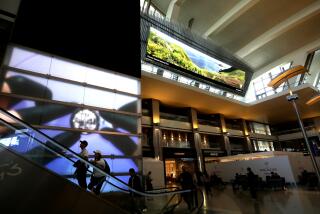‘Travelports’ Are Way to Go
Whether you are a seasoned air warrior accustomed to constant traveling for business or an occasional flier joining the holiday crowds, if you’ve been to an airport lately you know how much harder flying has gotten.
The airlines were already in trouble before the Sept. 11 attacks and now, with less travel and more delays, bankruptcy is the order of the day for some major carriers. And the cutbacks in service and amenities mean longer lines and even more delays.
The only carriers that seem to be doing at all well are the low-cost, point-to-point carriers like Southwest and JetBlue that have abandoned the hub-and-spoke model favored by the major airlines.
Instead of routing all trips from smaller cities into a few major hubs, these carriers hopscotch across the country, dispensing jokes, peanuts and little else but on-time service and low fares.
Does this signal the end of the hub-and-spoke system that has allowed major airports like Los Angeles International to become economic factors in their metropolitan areas? And are people from smaller cities now doomed to either no air service or an endless chain of short hops across the country?
Fortunately, there can be another model.
Europe has confronted the terrorist threat for years.
There, the traditional airline system is being replaced with an air-rail hub-and-spoke system, where people use airplanes for longer flights and transfer inside the airport to high-speed trains to complete their trips.
With increased congestion on the roads and security delays at the airports, trains are often the fastest way to travel up to 300 miles.
And if the train serves the airport directly, changing from plane to train can be as convenient as changing flights.
In the long run, an interconnected air-rail-bus system would provide higher-quality service to more locations at a lower cost to the environment and with far greater security than the current system.
Making the rail connection in Southern California certainly would be possible, if the Green Line were directly connected to LAX and with Burbank already on the proposed California high-speed rail corridor and Ontario envisioned as part of the L.A.-to-Las Vegas corridor.
Congress can create the framework for a new national transportation system next year when the funding legislation for air, rail, highways and mass transit all come due at the same time. What’s needed is a bill that does three things: maps a new, interconnected system for air, rail and bus; provides money to turn airports into “travelports,” with rail and bus terminals inside the airport; and funds upgrading of rail tracks to accommodate higher speed levels in key intercity corridors.
Such an investment in building a national transportation system for this century is far better than the next most likely action by Congress: providing the major airlines and Amtrak with yet another bailout.
Such a move would merely allow the rail and air industries to continue with the failed business models of the last century.
More to Read
Sign up for The Wild
We’ll help you find the best places to hike, bike and run, as well as the perfect silent spots for meditation and yoga.
You may occasionally receive promotional content from the Los Angeles Times.






